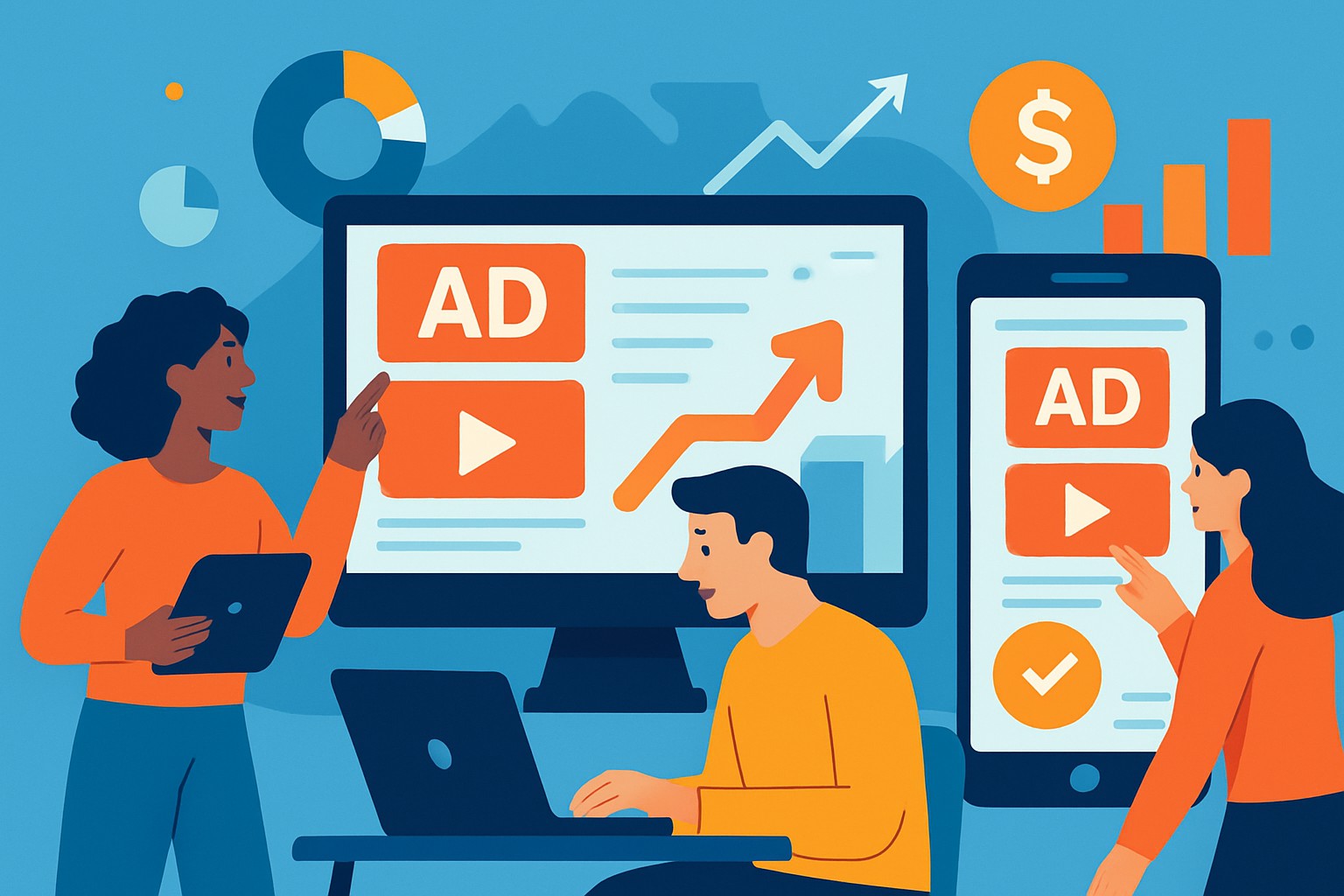Ad Persuasion Techniques That Convert Visitors


Discover advanced ad persuasion techniques crafted to turn casual browsers into loyal customers who keep coming back. By using psychology, sharp headlines and strategic visuals, you can create ads that boost conversion rates and fuel real business growth.
Exploring the Psychology Behind How Ads Persuade A Sneak Peek Into What Makes Us Tick
Ad persuasion often hinges on tapping into those sneaky subconscious decision-making processes. The most effective ads usually lean on cognitive biases and emotional cues to nudge visitors in the right direction without coming across as pushy or salesy.
- Social proof builds trust by showing the support and actions of others like when you spot a crowd and figure something’s worth checking out.
- Scarcity increases urgency by pointing out limited availability or ticking clocks and nudges us to act before the chance slips away.
- Reciprocity plays on the natural human urge to return favors. It’s like a friendly handshake in the world of influence.
- Authority earns its stripes through expert endorsements or official certifications giving it a weight that’s hard to ignore.
- Consistency taps into our deep desire to be seen as reliable and steady. It helps us stick to our choices without second-guessing.
- Emotional appeal connects with our core values, fears or desires and gently pushes us toward action with a nudge that feels personal.
Creating Headlines That Grab Attention in a Snap
The headline is basically the front door to your ad and it has to catch someone's eye instantly. I have found that effective headlines often lean on punchy words and clever numbers with just the right spark of curiosity to make individuals stop mid-scroll.
Choose impactful words like "proven," "exclusive" or "limited" to tug at the heartstrings and spark an emotional response.
Sprinkle in numbers or data to sharpen your message and make it clear.
Build a sense of curiosity that gently lures your audience in and makes them eager to learn more.
Lean on urgency and exclusivity—they work like a charm to nudge people into quick action.
Whenever possible, tailor your headlines so they resonate with your audience’s demographics or behavior. It’s like speaking their language and they’ll appreciate it.
Making the Most of Visual Persuasion in Ads
Visual elements are key players in making that all-important first impression and giving your conversion rates a nice nudge. By tapping into the magic of color psychology and picking images that really click with your audience, while arranging layouts with a bit of care, you’ll often see engagement shoot up.
- Choose contrasting colors that really make your CTAs pop and effortlessly catch the viewer's eye.
- Include images featuring real people or relatable situations that your audience can genuinely connect with.
- Use the classic rule of thirds to create balanced, visually pleasing layouts that feel right.
- Establish a clear visual hierarchy so the most important messages don’t get lost in the shuffle.
- Keep your ads clean and uncluttered to help people focus on the core offer or message without distractions.

Example of a visually persuasive ad maximizing contrast, imagery, and layout to drive conversions.
Getting a Handle on Social Proof in Advertising (Because Everyone Loves a Good Crowd-pleaser)
Social proof hits the mark because people often follow the crowd without realizing it. Tossing in testimonials, user-generated content and trust badges to your ads speeds up that trust-building process and quiets any lingering doubts. It’s like giving your audience a little nudge with real-world validation that gently says "Hey, these people know what they’re talking about."
Feature genuine customer reviews that highlight specific benefits. These real voices often speak louder than any polished marketing spiel.
Include endorsements from trusted influencers or experts who truly know their stuff in the field and lend that extra layer of credibility.
Share usage data showing broad adoption and positive outcomes. Numbers can be dry, but they tell a powerful story when you connect the dots.
Add brief case studies to spotlight actual results to give your audience relatable scenarios rather than just abstract claims.
Highlight awards or certifications that confirm quality and reliability. Those little badges of honor can go a long way in building trust.
How to Optimize Call-to-Actions (CTAs) for Better Conversion (Because Clicking Matters)
Creating an effective CTA is about more than just slapping a Buy Now button on the page. It takes a bit of art and science. Strong copywriting, thoughtful placement and a design that catches the eye all team up to give your click-through and conversion rates a real boost.
- Use clear action-packed verbs like Get, Download and Start to make your intent obvious. No beating around the bush here.
- Build a little urgency or exclusivity with phrases such as Limited offer or Today only. It’s amazing how a tiny nudge can spark action.
- Keep your CTAs straightforward and to the point to avoid confusion or hesitation. Sometimes less really is more.
- Don’t hesitate to experiment with different colors and sizes because finding that sweet spot can seriously boost your clicks.
- Make sure your CTAs appear prominently above the fold so they catch the eye right away without making people scroll hunting for them.
How to Use Scarcity and Urgency Without Sending Visitors Running for the Hills
Scarcity and urgency can really give conversions a solid boost but they’ve got to be handled with care to keep that trust intact. When scarcity tactics are upfront and honest, they spark genuine excitement and nudge people into action.
- Clearly spell out limited-time offers with their exact start and end times, so nobody’s left scratching their heads.
- Use countdown timers that update in real time to crank up that sense of urgency—you know, that little nudge to act fast.
- Toss in exclusive bonuses for those quick on the draw, making them feel like VIPs who just scored big.
- Share when quantities are running low, because nothing says real scarcity like a little behind-the-scenes peek.
- Shine a spotlight on early bird specials that reward those who jump in first—after all, the early bird does catch the worm.
Personalization Techniques That Somehow Always Seem to Make Ads Click a Little Better
Data-driven personalization usually works wonders for boosting ad relevance by tailoring messages to match visitor behavior and demographics. When ads speak directly to someone’s unique needs they tend to create a deeper emotional connection and drive better conversion rates.
Use dynamic text replacement to switch up headlines or offers depending on where your visitors are coming from or what’s catching their eye—it’s like speaking their language without saying a word.
Retarget visitors with personalized offers tailored to their past browsing or purchase history. It’s like reminding an old friend about something they loved last time.
Segment your audience based on buyer intent so you can deliver messages that truly hit the mark when it matters most. Timing is everything.
Trigger ads based on user behavior such as how long they linger on a page or how far they scroll. Think of it as reading their digital body language.
Use geo-targeting to customize promotions and language according to location data—it’s about making your message feel right at home.
Common Mistakes People Often Make When Trying to Persuade with Ads
Even the most well-crafted ads can trip up when key mistakes sneak in. Overstating claims, forgetting about mobile users or not giving clear CTAs usually tanks credibility and drags down conversions.
- Making exaggerated claims that tend to raise eyebrows and chip away at trust.
- Forgetting to include a clear, compelling call-to-action that really grabs attention.
- Overlooking mobile optimization results in a frustrating user experience.
- Showing weak or fuzzy value propositions that can leave visitors scratching their heads.
- Skipping A/B testing misses golden opportunities to gradually boost performance.
How to Measure and Improve the Effectiveness of Ad Persuasion—A Practical Approach
Effective ad persuasion isn’t just a one-and-done deal. It’s something you can track and gradually improve over time. Keep a close eye on metrics like CTR and conversion rate as well as bounce rate. Pair that with A/B testing and heatmaps or click tracking tools to get under the hood of visitor behavior.
| Metric Name | Description | Why It Matters | Optimization Tips |
|---|---|---|---|
| Click-Through Rate | The percentage of visitors who actually take the plunge and click on your ad | Gives you a good pulse on how relevant and eye-catching your ad really is | Don’t be shy to play around with different headlines and CTA placements; throw in some colors that really pop to grab attention |
| Conversion Rate | The percentage of visitors who follow through and complete the action you want | This one’s all about how well your ad moves the needle when it comes to results | Tweak your landing pages, make CTAs crystal clear, and customize your messaging so it really speaks to your audience |
| Bounce Rate | The percentage of visitors who drop off without any interaction | Tells you if your ad’s promise matches what visitors find or if they’re turning tail | Fine-tune your targeting and ad copy, and pump up the relevance of your landing page to keep people sticking around |
| Heatmap Data | A colorful snapshot showing where individuals click and engage on your ad pages | Lets you spot what’s catching eyes and what’s being totally ignored | Mix up your layouts to bring CTAs and key offers front and center |
| Time on Page | How long, on average, visitors hang out on your page after clicking through | A pretty good hint at how hooked they are on your content | Beef up content clarity, speed up the page, and polish the overall look |




